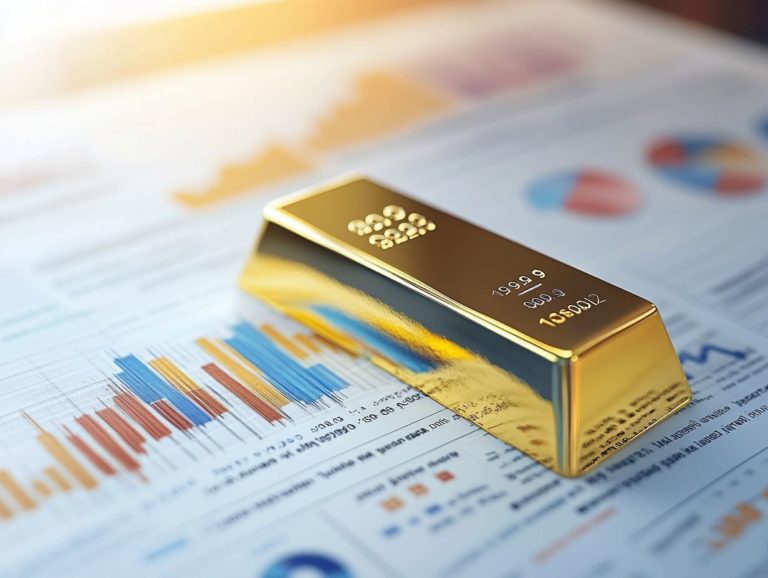Is Gold Mining a Worthwhile Investment?
Gold mining has consistently intrigued investors with its allure of wealth and stability. As a tangible asset, gold often acts as a reliable hedge against economic uncertainty.
This article delves into the intricacies of gold mining from the extraction process to the multifaceted factors that influence gold prices. It weighs the pros and cons of investing in this sector and guides you through various investment options.
You ll find key metrics to evaluate gold mining companies, empowering you to make informed decisions.
Get ready to discover the exciting opportunities in gold mining!
Contents
- Key Takeaways:
- Overview of Gold Mining
- Factors Affecting Gold Prices
- Pros and Cons of Investing in Gold Mining
- How to Invest in Gold Mining
- Evaluating the Potential of Gold Mining Companies
- Frequently Asked Questions
- What is gold mining and why is it considered a worthwhile investment?
- What are the advantages of investing in gold mining?
- What are the risks of investing in gold mining?
- How do current market and economic conditions affect the profitability of gold mining investments?
- What are the different ways to invest in gold mining?
- Is gold mining a suitable investment for everyone?
Key Takeaways:

- Gold mining is a potentially profitable investment you don t want to miss! However, careful evaluation of risks is crucial.
- Factors like global economic trends and political stability can significantly impact gold prices, making this a volatile investment.
- Thorough research on different investment options is essential. Evaluate companies based on key indicators and metrics.
Overview of Gold Mining
Gold mining is a complex endeavor that involves extracting gold from the earth. It requires substantial investments in technology, labor, and infrastructure. This precious metal has long been viewed as a sanctuary for investors, especially during periods of market volatility.
The gold mining sector not only bolsters the supply of gold bullion and coins but also enhances the production volume of gold stocks. These stocks play a crucial role in portfolio diversification and capital appreciation strategies, making them valuable assets in your investment arsenal.
Explanation of the Process
The journey of gold mining unfolds through a few key steps, starting with exploration to pinpoint potential sites rich in gold deposits. This initial phase requires significant investment in geological surveys studies that help find where gold might be located and advanced technology to evaluate the feasibility of these locations.
Once a promising site is identified, the operation transitions into the extraction phase, where gold is mined using methods such as open-pit or underground mining. This stage incurs considerable operational costs, including labor, machinery, and safety precautions, all of which can directly impact gold prices in the market.
After extraction, refining purifies the gold and enhances its quality and market value. As these processes unfold, environmental considerations emerge as a top priority, with sustainable practices increasingly demanded by stakeholders and regulators.
By understanding these intricate processes, you can effectively navigate the complexities of the gold market and anticipate fluctuations driven by evolving market conditions.
Factors Affecting Gold Prices
The price of gold is shaped by a complex interplay of factors, including economic conditions, inflation rates, and the decisions made by central banks globally. As a tangible asset, gold tends to respond to market dynamics, serving as a reliable hedge against inflation and price volatility. This makes it an essential element in many investors’ portfolios.
By grasping these variables, you can make well-informed decisions about your gold investments and refine your overall investment strategy.
Now is the time to act and explore the potential of gold as a valuable investment!
Global and Economic Influences

Global and economic influences shape gold prices as market sentiment and investor behavior shift in response to world events and macroeconomic trends.
Crisis events like the 2008 financial meltdown and the COVID-19 pandemic transformed investor perceptions, driving demand for gold as a safe haven. Policy changes, such as interest rate adjustments and inflationary pressures, can amplify this volatility.
When central banks hint at lowering interest rates, expect a surge in investor interest for gold, often due to concerns over potential dollar devaluation.
Fluctuating economic indicators like employment rates and manufacturing outputs also influence market dynamics. This creates an environment where gold prices can react sharply to changing investor sentiment.
Pros and Cons of Investing in Gold Mining
Investing in gold mining has a unique set of advantages and disadvantages to consider.
On one hand, gold mining offers the potential for significant capital appreciation and serves as a safeguard against inflation and economic instability.
On the other hand, it involves risks like market volatility and operational challenges that can affect production levels and overall returns.
Potential Benefits
The benefits of investing in gold mining are compelling. You can achieve capital appreciation, portfolio diversification, and a reliable safe haven during downturns.
Investing in gold mining stocks can lead to long-term capital gains, especially during inflation or currency devaluation. The intrinsic value of gold often balances the volatility in traditional markets, providing stability in uncertain conditions.
This investment can enhance your overall portfolio performance, helping to mitigate risks associated with equities and bonds. Researching specific mining companies, industry trends, and global gold demand will enable you to make informed decisions and pave the way for substantial wealth accumulation.
Possible Risks
Investing in gold mining carries risks, including market volatility, operational challenges, and fluctuating gold prices that can dramatically affect returns.
Stay alert to geopolitical risks that may disrupt operations, particularly in regions with political instability. Poor management decisions can lead to inefficiencies or even failed projects that negatively impact profits.
New environmental regulations might introduce compliance requirements, influencing operational costs and timelines. If you’re thinking about adding gold mining to your portfolio, carefully evaluate these risks, as they shape your investment strategies and asset allocation.
How to Invest in Gold Mining

When investing in gold mining, you have a range of sophisticated options. Explore gold stocks, ETFs (Exchange-Traded Funds), and futures.
Each avenue presents distinct advantages, allowing you to tailor your strategy to fit your individual goals and preferences.
Different Investment Options
When you explore how to invest in gold mining, you ll find options like gold stocks, ETFs (Exchange-Traded Funds), and gold futures. Each offers distinct pathways to gain exposure in this sector.
These investment choices have unique characteristics and risk profiles, catering to various needs and strategies. Gold stocks are shares in companies directly involved in mining. Their performance depends on gold prices and company-specific factors like management efficiency and operational costs.
ETFs allow you to invest in a diversified basket of gold-related assets. This minimizes your exposure risk by spreading investments across multiple companies or gold holdings. If you’re more seasoned in the investment arena, you’ll find gold futures as exciting opportunities! These contracts obligate you to buy or sell gold at a predetermined future date and price, offering potential for substantial gains or losses depending on market movements.
Understanding these differences is essential for effectively diversifying your portfolio. Each investment option can play a unique role in balancing risk and return within your overall investment strategy.
Evaluating the Potential of Gold Mining Companies
When evaluating the potential of gold mining companies, it’s essential to analyze key indicators and metrics. This analysis reveals valuable insights into their operational efficiency, production volume, and overall financial health.
By carefully examining these factors, you’ll gain a clearer understanding of their viability and prospects in the market.
Key Indicators and Metrics to Consider
Key indicators for evaluating gold mining companies include production costs, gold reserves, and historical performance against market trends. Understanding these factors is crucial, as they provide insights into the company’s operational efficiency and potential profitability.
For example, production costs directly impact profit margins; companies that keep costs low are better positioned to handle price fluctuations, strengthening your investment thesis. Gold reserves reflect the longevity and sustainability of a mining operation, which affects future cash flows.
By analyzing historical performance against market trends, you can better anticipate how a company may respond to economic shifts. Conducting thorough research will significantly enhance your decision-making, reduce risks, and maximize potential returns in your investment strategy.
Frequently Asked Questions

What is gold mining and why is it considered a worthwhile investment?
Gold mining means taking gold from the ground. It is considered a worthwhile investment due to the high demand and value of gold, making it a potential source of profit for investors.
What are the advantages of investing in gold mining?
Some advantages include potential for high returns, diversification of your investment portfolio, and protection against inflation and economic instability.
What are the risks of investing in gold mining?
Like any investment, gold mining comes with risks. Some potential risks include fluctuations in gold prices, environmental and regulatory challenges, and operational risks such as production delays or accidents.
How do current market and economic conditions affect the profitability of gold mining investments?
The profitability can be affected by various factors such as demand and supply of gold, inflation rates, and geopolitical events. It is important to stay informed and monitor these conditions when considering investments.
What are the different ways to invest in gold mining?
Investors can buy stocks of gold mining companies, purchase physical gold, invest in ETFs that track gold mining stocks, or invest in mutual funds that have exposure to gold mining companies.
Is gold mining a suitable investment for everyone?
Gold mining can be a great way to add variety to your investments. It s especially good for those with a long-term view.
Before you dive in, make sure to research thoroughly. Consulting a financial advisor can also help you make smart choices.














